► CAR reviews new BMW i3 REX
► We live with i3 Range Extender
► 94Ah EV battery range on test
Month 12 of our BMW i3 long-term test: the verdict
Almost exactly one year after it arrived on CAR’s fleet, the slate grey BMW i3 has gone, leaving me with pangs of loss. It didn’t set my trousers on fire dynamically, nor can I fondly recall individual drives, but the i3 fostered a new type of connection.
It’s the modernism at the heart of the i3 where the magic happens. When you open the pillarless doors and sink into the minimalist cabin you feel good – it’s decluttered, and roomy with that lack of central transmission tunnel. Optional £780 twin sunroofs bathe the recycled dashboard in daylight, while the suicide rear doors draw more interest than ire (the fronts must be open before the rears).
We regularly carried four passengers – this is a roomy car for something less than four metres long. A practical small electric car? Nearly. There’s no fifth seat and the boot is tiny with barely any space for more than a couple of soft bags. Blame the battery pack and rear-mounted engine – but we often flopped the back seats down to swallow bigger loads.
What really wormed its way into our affections was the think-different side of BMW i ownership. I felt a frisson of excitement every time I opened the door and glimpsed the carbonfibre cell; this car is stiff and light for a small EV, lending a deft touch to handling and agility.
The best hybrid cars on sale
What is a hybrid car? Our guide to hybrids, PHEVs and plug-ins
Our guide to electric BMW cars
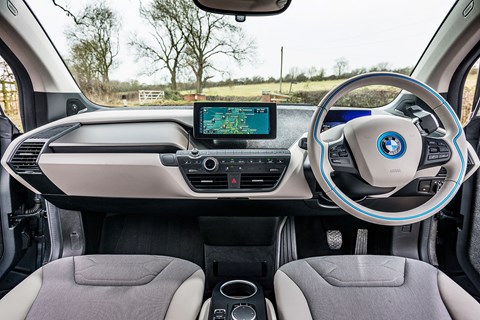
There’s no doubting it’s a BMW. Munich has that knack of blessing all its products with a family feel and the controls, pedals and stalks operate with a slick precision that’ll be familiar to anyone who’s ever driven a 3-series.
The electric drivetrain is magical, pouring down the road with surprising vigour. BMW quotes 0-62mph in 8.1sec, but it’s as quick as an E90 M3 to 30mph and feels it. Once that party trick’s over, you learn to play the system, conserving battery power by anticipating traffic, cruising down hills and nibbling the throttle up them. It’s a new way of motoring we’ll all have to learn and the i3 helps with unobtrusive instruments to guide your leaden right foot.
And when the battery charge gets low and range anxiety kicks in, our car’s tiny Range Extender (REX) petrol twin comes into play. This is the genius get-out-of-jail card. Living in the rural Midlands, I could’ve coped with a pure electric i3 but I wouldn’t have been able to take it to Thruxton or Heathrow with such ease. I only used the REX for these longer journeys and sometimes went for months without refuelling.
Should you still buy a diesel car? We look at the future of derv
Over nearly 10,000 miles it drank a modest 193 litres of unleaded, meaning a nominal 165.8mpg fuel consumption figure at a cost of £231.17p. Electrical consumption is harder to measure because this car was used by nine CAR staffers, but our calculations suggest we travelled 3.4 miles per kilowatt hour, typically costing us £3.50 for every 100 miles.
This is the ultimate feelgood factor of the i3. It’s cool, it’s modern, it’s saving the planet – and your wallet. Bravo BMW. If this is the shape of things to come, consider us signed up to the future.
By Tim Pollard
Logbook: BMW i3
Engine 125kW electric motor (equivalent to 168bhp, 184lb ft), with 647cc 2-cyl petrol range extender
Gearbox Single-speed automatic, rear-wheel drive
Stats 8.1sec 0-62mph, 93mph, 13g/km CO2
Price £31,560
As tested £37,009 (prices quoted after govt Plug-in Grant)
Miles this month 511
Total 9874
Our mpg 165mpg
Official mpg 471mpg
Fuel this month £6.29
Extra costs None
Count the cost: BMW i3
Cost new £37,009 (including £5449 of options)
Dealer sale price £29,944
Private sale price £27,989
Part-exchange price £26,944
Cost per mile 2.3p (petrol) 3.5p (electricity)
Cost per mile inc. depreciation £1.08
Month 11 of our BMW i3 long-term test review: it’s been usurped by a facelift
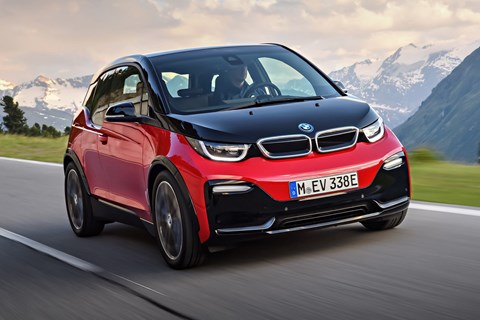
Our stint with the i3 is nearly at an end. It’s facelift time, see, though you’d be hard pressed to tell from the car (above) unveiled in Frankfurt. Blacked-out A-pillars and roof lines, some fresh paint choices, reprofiled bumpers and a chrome strip running across the rear are about your lot.
What is new is the i3 S, a warm hatch with 10mm lower suspension, 20mm wider tyres and 0-62mph in 6.9sec. Count us as interested…
You can read our full BMW i3 S review here.
By Tim Pollard
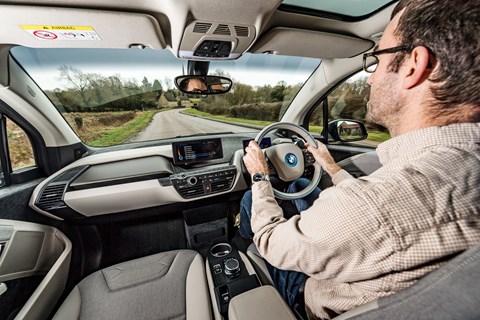
Month 10 running a BMW i3 REX: what do other owners think of BMW’s electric car?
This month’s big picture (above) is what the i3 is all about: it’s a reminder that electric cars can be fun to drive! This is heartening news in an age where it’s easy to be sucked into a vortex of negativity about the future of motoring, automotive pleasures as know them crippled by taxation, emissions, congestion and headline-grabbing ministers pledging to eradicate every trace of internal combustion by 2040.
You see, the BMW i3 is a stepping-stone car – a product bridging the gap between yesteryear and the brave new world of tomorrow. No wonder it’s won an evangelical following all of its own in the four years it’s been on sale. Browse the internet and you’ll find numerous groups on Facebook and elsewhere dedicated to the electric BMW i cars. And quite a few of them have been corresponding with me to share their experiences. That’s Steve Clarke below, who chose a 94Ah range-extender like ours ahead of a Tesla Model S.
Read our guide to the best electric cars and EVs on sale in the UK
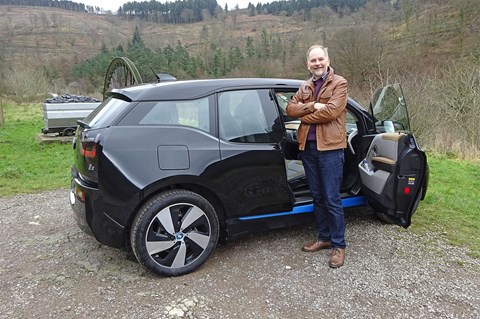
He took out a two-year PCP and haggled an additional £3500 discount on top of the government’s plug-in grant, with attractive zero per cent finance. Saving £8k on an i3 sounds like a cracking deal to us. ‘I love it, it’s great to drive,’ says Steve, who lives in Wales. ‘City driving is fun again, it’s so easy to drive and manoeuvre.
‘The steering is light; initially I was concerned about this when I had a test drive, but once you get used to it, it’s less tiring. It still feels very involving to drive and still feels like a BMW. This is my ninth BMW.’
Another Munich loyalist is Robert Baldrey from Cambridgeshire, who’s owned 5-series and X5s before. ‘I was using my 520d for work and we found we were spending around £180 a week on diesel between the two cars! I started to look at ways we could bring the fuel bill down and really liked the look of the i3.’
One year later, Robert reports that his electricity bill has gone up about £50 a month after installing the official BMW wallbox. But he’s crunched the maths and reckons he’s spent £600 on electricity for 20,000 miles – around 3p per mile.
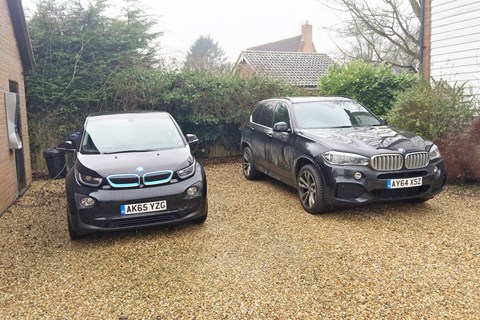
Result? A net saving of nearly £4000 a year compared with his conventional fleet. Both readers rave about the pre-conditioning feature that lets you warm up the cabin in advance – a godsend in winter. Robert, who also owns a Porsche 964 Turbo, likes the i3’s acceleration (‘ridiculously addictive’), while the taxi-spec turning circle remains a favourite party trick.
What would they improve? The lack of a fifth rear seat is a grumble, while the wobbly cold-weather grip and feeble air-con are singled out for criticism by Robert. And Steve bemoans the (optional) rear-view camera that gets filthy too quickly. But it’s clear these early adopters love their i3s. And so do we.
By Tim Pollard
Logbook: BMW i3
Engine 125kW electric motor (equivalent to 168bhp, 184lb ft), with 647cc 2-cyl petrol range extender
Gearbox Single-speed automatic, rear-wheel drive
Stats 8.1sec 0-62mph, 93mph, 13g/km CO2
Price £31,560
As tested £37,009 (prices quoted after govt Plug-in Grant)
Miles this month 313
Total 8509
Our mpg 209.9mpg
Official mpg 471mpg
Fuel this month £11.70
Extra costs None
Month 9 running a BMW i3 REX: its periodic table composite specs
Our BMW i3’s exposed carbonfibre sills are a visible reminder of how this supermini is more super than any rival in a game of periodic table bragging rights. Both i3 and i8 are built around a composite ‘Life module’ and this lightweighting contributes to 1440kg at the kerb; drop our range-extender’s twin-cylinder engine and that falls to 1320kg – 150kg less than a Renault Zoe or Nissan Leaf.
Then again, the cool black weave also explains why the i3 costs substantially more than rivals. At time of writing, the range starts at £33,070 for the cheapest EV model, while a Zoe kicks off at £14,245 (though battery hire costs a further £59 a month) and the soon-to-be-superseded Leaf begins at £16,680 if you lease the battery, or £21,680 if you buy the battery outright.
You can see how complicated electric car ownership can be… That’s one of the joys of the simplicity offered by the BMW. There are no tricky decisions on whether to buy or lease the power source – you merely choose whether to go pure EV or range-extender (REX), like ours.

There are other perks to the unobtainium build quality of the i3. That carbonfibre tub gives it a brilliantly stiff foundation for everything to hang off: the handling is consequently delightfully accurate, with pin-sharp steering and a pleasing, very BMW manner in which it pours down the road.
The car never wobbles or shimmies over rough surfaces. And – I hope never to test this – it’ll surely make a very safe crash structure to protect occupants in the event of an accident (see Euro NCAP crash test above, though it only won four stars owing to poor pedestrian safety and the lack of driving alerts and aids).
By Tim Pollard
Diary update: BMW Connected app and the i3
We’ve yet to really mention the clever connectivity available on the i3 range. Download the BMW Connected app from the appstore and you can control many of the vehicle’s functions remotely.
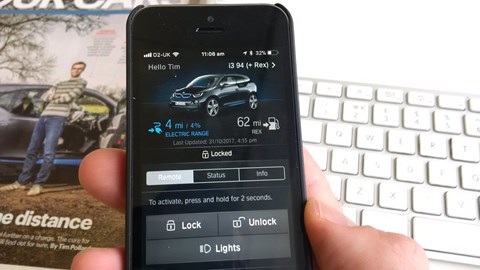
It’s a cinch to use and we’ve been playing around with various functions. We rate them here:
- THE USEFUL
- Check car’s range (electric and fuel) remotely
- Operate climate control remotely (great for heating or cooling your car for up to 30 minutes so it’s a nice temperature when you arrive)
- Locate vehicle (yes, yes – I admit it… I have forgotten where in an airport car park I’ve left it before!)
- Remote servicing indicator: tells you when your fluids need changing (July 2018, as it happens)
- Tyre pressure check – useful to know your tyres are inflated correctly from your armchair
- Sync with Apple Watch and Amazon Alexa: I own neither, but have tested both and this added functionality will blossom in future
- Locate your nearest BMW dealership and book an appointment: we’ve not needed to do this, but it’s clever
- Send a journey to the car’s sat-nav from your phone. A handy feature
- It’ll even sync with your calendar and provide time-to-leave notifications, taking into account traffic and delays. Clever stuff…
- BIT GIMMICKY
- Lock or unlock the car remotely (still haven’t really seen the point in this, though others report it’s handy)
- Flash the lights from your phone – could be handy to locate your car in a busy multistorey, I guess
- Scheduling charging: I tend to do this in the vehicle, but you can programme the i3 to charge up on off-peak rates remotely
The great thing is, you don’t have to use the app if you don’t want to or are just old-fashioned and prefer to declutter the gadgets and tech pervading many people’s modern lives. But the i3 is a class example of just how cars are being integrated into the internet of things. The power of the cloud is bringing plenty of clever features to BMWs – and probably your next car too.
Ignore it at your peril…
By Tim Pollard
More tech stories by CAR magazine
Month 8 living with a BMW i3 REX 94Ah: up close and personal
Twin sunroofs!
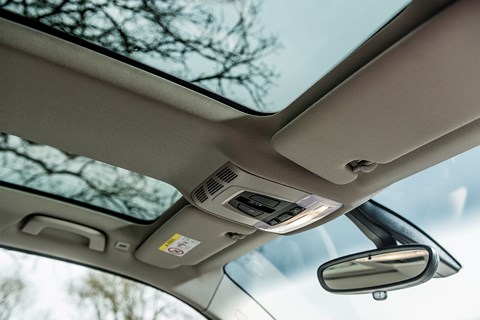
The i3 is blessed with lots of light, thanks to its big glasshouse and optional £780 sunroof. It lets daylight pour into the cabin and opens for that 1980s fresh-air feeling. Although the glass panel itself slides as one, a split internal frame lets driver and passenger open and close the sunblinds individually.
Running costs
The i3 is a proper fuel miser. We’ve averaged 152mpg this month and run it most of the time as an EV, only resorting to ICE on longer journeys. What’s the e-cost? We’re averaging 3.4 miles for every kilowatt hour; at an average of 12p per kWh, charging is costing us around £3.50 every 100 miles. Bargain!
Space-age gearlever
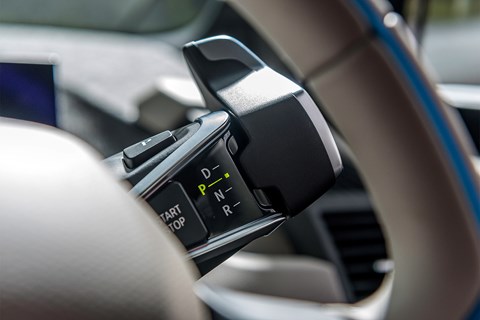
Takes a bit of getting used to, this. The i3’s gearlever is quite something, a big rotary dial to the right of the steering wheel. Despite appearances it’s intuitive to use: you twist it forwards for D and roll it back towards you for R. There’s also the bonus of a totally flat floor between the front seats.
The headlamps
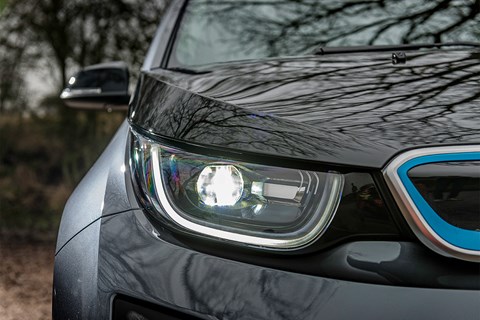
Our i3 has the LED headlight option, at £710. They’re brilliantly bright and cut through night-time gloom very effectively – but with none of the swivelling, turning, active shuttering tricks of newer BMWs with more intelligent dynamic headlamps. Thankfully, the facelift has arrived…
By Tim Pollard
Logbook: BMW i3
Engine 125kW electric motor (equivalent to 168bhp, 184lb ft), with 647cc 2-cyl petrol range extender
Gearbox Single-speed automatic, rear-wheel drive
Stats 8.1sec 0-62mph, 93mph, 13g/km CO2
Price £31,560
As tested £37,009 (prices quoted after govt Plug-in Grant)
Miles this month 563
Total 7586
Our mpg 152.5mpg
Official mpg 471mpg
Fuel this month £27
Extra costs None
Month 7 living with a BMW i3 REX 94Ah: when gates attack!
Mishap alert.
Returning late on a blustery evening, I opened my gate and reversed in… only to hear an awful keerrrunch as door mirror hit gate. It’s a manoeuvre I’ve done daily for 10 years, but on this occasion the wind had blown the gate half-shut.
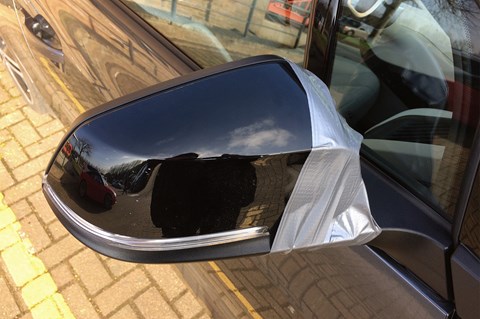
When we heard the quote for a new mirror (£600+), it became an insurance job. After a couple of hours at dealer Sycamore, it’s business as usual.
By Tim Pollard
Logbook: BMW i3
Engine 125kW electric motor (equivalent to 168bhp, 184lb ft), with 647cc 2-cyl petrol range extender
Gearbox Single-speed automatic, rear-wheel drive
Stats 8.1sec 0-62mph, 93mph, 13g/km CO2
Price £31,560
As tested £37,009 (prices quoted after govt Plug-in Grant)
Miles this month 1028
Total
Our mpg 150.5mpg
Official mpg 471mpg
Fuel this month £38.53
Extra costs £191.39 (new tyre)
Month 6 living with a BMW i3 REX 94Ah: meeting big brother, the BMW i8 sports car
We’ve been living the i life in 2017, as not one but two fruits of BMW’s Project i have graced CAR’s long-term test fleet. It’s made for an intriguing comparison. The i8 recently departed these shores, but I made sure to spend decent time behind the wheel before its svelte, low-slung silhouette went off to its new home.
Read our full BMW i8 long-term test review here.
They’re remarkably different cars, but with enough common DNA that you’ll make the connection. My i3 is a boxy, upright car whose silhouette reminds me of its futuristic, pod-like Megacity Vehicle development codename.
It looks like nothing else on the road, but those proportions cleverly provide decent accommodation for four passengers in a car no longer than a Nissan Micra. Slab sides do mean you’re buffeted quite a bit during strong winds, however.
Park next to the i8 and you feel like a sixth-former looking down on the new year’s junior intake. It’s a low, squat, purposeful car by comparison, with tighter packaging (the +2 rear seats are on a par with a 911’s) and a more menacing stance. But check out the similarities: the distinctive edge to the BMW kidney grille; the U-shaped headlamp graphic; the flashes of zingy blue and two-tone accent colours on the plastic bodywork.
If you want to play streetside posing, the i8 wins hands down. Those scissor doors and craftily wrought aero body addenda see to that. But the i3 wears its age well, and still cuts a dash on the school run, especially with its own trick rear doors.
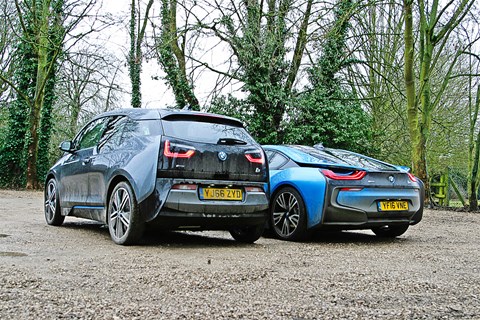
The i3 will be facelifted later this year while an i8 Spider is imminent – it’ll be interesting to see how the aesthetic evolves. One area both BMs are let down by is their electronic architecture: aged infotainment, iDrive functionality and cockpit vibe are at odds with their pioneering powertrain and construction.
Jump into a new Five or Seven and you can twirl your fingers in the air to change the volume or bat away phone calls like you’re starring in Minority Report VI; in this pair everything feels a bit last decade, as you’re stuck with physical buttons and clunky voice control. This is fast forgotten on the move, however. The way the i3 and i8 pour down the road, all electric shove and pliant ride and pointy steering, is perhaps their greatest shared asset. Both benefit from rigid carbonfibre tubs and you can feel it in the way they handle a wiggling, bumpy back road, with a stiff, well measured accuracy to proceedings.
The i3 is devilishly fast off the line (as fast 0-30mph as an M3, remember?) but gives up the ghost earlier at higher velocities. It suits a more relaxed gait. The i8? It’s a fast car, period – and feels like something from the future.
I’m convinced they’re both landmark cars, stepping stones to the new era of electromobility we’re rapidly fast-forwarding towards. They’re not without compromises – and they’re both very expensive to buy – but I suppose that’s the price of progress.
By Tim Pollard
Month 5 of our BMW i3 REX long-term test review: the rear doors put to the test
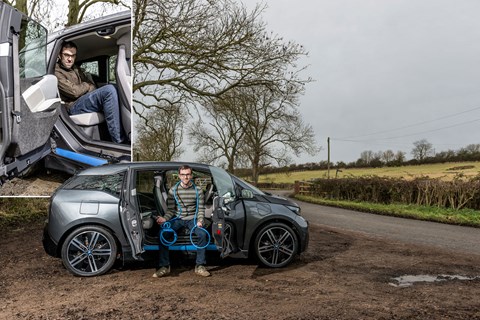
Suicide doors, coach doors, rear-hinged doors… the BMW Group has form with unconventional hinges, although the i3’s ‘opposing doors’ are somewhat smaller than those on distant Rolls-Royce cousins.
They add just 28cm extra space to access the rear bench; this is disguised by the fact that the front doors have to be open first – a tad unhelpful when offloading the kids. And front seatbelts must be unbuckled, too…
Still, there are upsides. The i3’s back doors are cooed over far and wide, adding to the streetside drama. And the lack of a B-pillar means that clambering in and out is a cinch.
Room for legs and heads is adequate for adults and generous for kids, helped by the lack of a transmission tunnel. The i3 isn’t often used as a family car, but it trumps many superminis.
By Tim Pollard
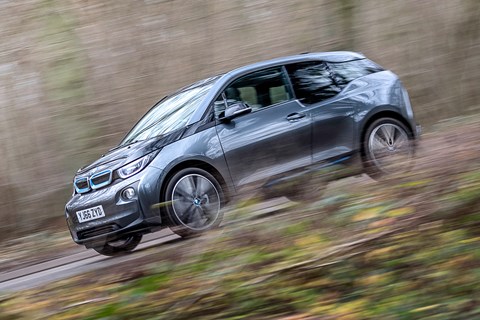
Month 4 living with a BMW i3: futuristic car, old-fashioned fault
We’re four months into BMW i3 ownership and the little electric car with range extender is fully bolted into our lives. If you’re an electric car sceptic, we’d urge you to test drive one. It’s the perfect vehicle to turn you into an EVangelist.
Here’s why. Approach the car every morning and it radiates quality: the doors are engineered with reassuring Teutonic heft and we love climbing over the exposed carbonfibre door sills into the pre-heated cabin each morning.
But that electric powertrain is what’s really squirrelled into our affections. We love the easy thrust at low speeds, the saintly silence, the
virtual halo we imagine above our heads on every drive. It’s a tangible feelgood factor reinforced by the fact I’ve personally only filled up twice with petrol since December.
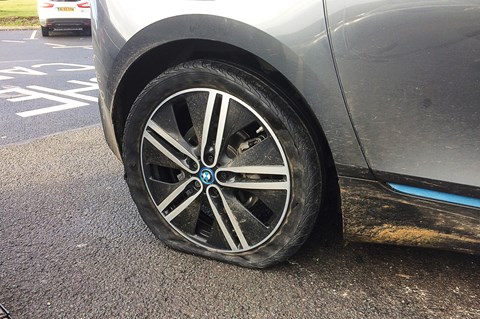
That’s because we charge this PHEV up every day outside the office – giving us maximum range for minimum anxiety. The reality is, we only use the range-extender on journeys over 100 miles – everything else is pure EV. Our average fuel consumption of 150.5mpg over some 2500
miles reflects its predominantly battery operation.
Editor Ben Miller was driving the i3 when he suffered a blow-out on the A1. He reports that the i3 behaved impeccably, tyre pressure monitor alerting him promptly before the
tyre disintegrated, leaving him time to limp to Peterborough services before the pressure got too low.
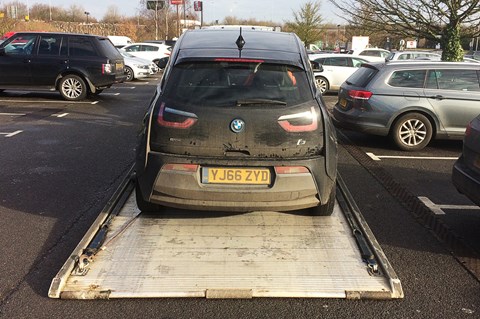
The Bridgestone Ecopia EP500 was destroyed and there’s no spare wheel in the minimalist i3 – leaving us no option but to call BMW Assist for recovery. All new BMWs come with three years of roadside assistance, and help arrived promptly in just under an hour to collect the stranded car.
Which is all well and good, but they are only authorised to trailer to main dealers, leaving us no choice but to travel to Sycamore in Peterborough. They charged us £191 for one super-skinny 155/60 R20 tyre, sourced and fitted within 24 hours and leaving us with an immaculately valeted car (though not a fully charged one, disappointingly).
Had we been able to shop around, Blackcircles.com quotes £161 for the same tyre. It was our first taste of BMW i dealer care and it was slick, if pricey.
By Tim Pollard
Logbook: BMW i3
Engine 125kW electric motor (equivalent to 168bhp, 184lb ft), with 647cc 2-cyl petrol range extender
Gearbox Single-speed automatic, rear-wheel drive
Stats 8.1sec 0-62mph, 93mph, 13g/km CO2
Price £31,560
As tested £37,009 (prices quoted after govt Plug-in Grant)
Miles this month 848
Total 4481
Our mpg 150.5mpg
Official mpg 471mpg
Fuel this month £38.53
Extra costs £191.39 (new tyre)
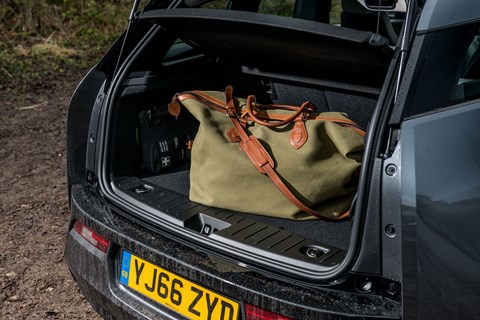
Month 3 living with a BMW i3: bootspace, practicality
This is a small car, just 3999mm long. It’s perfect for threading around town, and happy when you head to your favourite B-road. Yet its 1578mm loft provides an airiness that belies those pert dimensions.
Is it practical though? The rear load bay is just 260 litres and is quickly filled by a cricket kit bag or a couple of soft overnight bags, though it’s easy enough to flop the 50:50 rear seats forward to extend the bootspace. It’ll easily swallow our puppy’s crate with the back seats folded down.
Access to the boot is easy: there’s no lip whatsoever and a couple of elasticated straps are useful for holding items in place. Just remember that the i3’s two charging cables gobble up quite a bit of the scant bootspace before you’ve even put any of your luggage and bags in. It’s only 260 litres big, so this is not a roomy supermini (though you can collapse the rear seats flat for a larger 1100-litre space.
And that front ‘boot’ (below) is more of a glovebox for storing things you don’t mind getting damp. It’s basically left unused save for the puncture repair kit.
By Tim Pollard
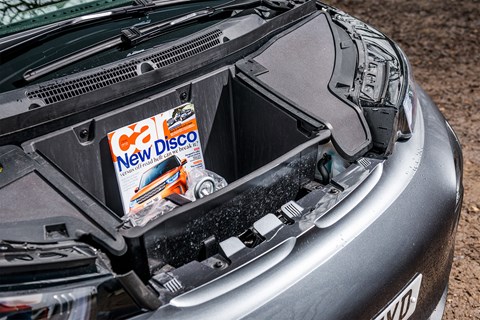
Logbook: BMW i3
Engine 125kW electric motor (equivalent to 168bhp, 184lb ft), with 647cc 2-cyl petrol range extender
Gearbox Single-speed automatic, rear-wheel drive
Stats 8.1sec 0-62mph, 93mph, 13g/km CO2
Price £31,560
As tested £37,009 (prices quoted after govt Plug-in Grant)
Miles this month 680
Total 3633
Our mpg 191.9
Official mpg 471mpg
Fuel this month £29.12
Extra costs £191.39 (new tyre – more next month)
Diary update: carbon dating with our BMW i3
Every time you climb into the BMW i3, you’ll notice something rather special: its carbonfibre construction. You can’t help notice it, as you open the door and swing your legs over the composite tub.
This isn’t exactly a flyweight small car, at 1440kg in range-extending REX form, but using space-age materials in its core is a useful counter to the heft of battery.
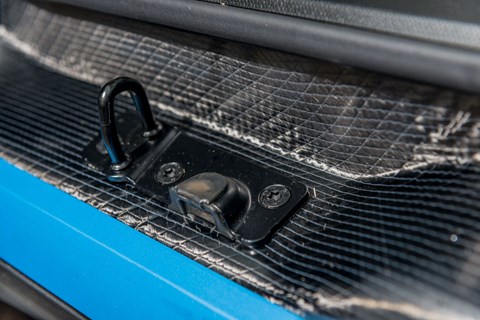
The i3’s design leaves an exposed strip of the dark grey plastic visible on the sill (above) – its high-tech weave is not quite McLaren-polished, but it’s a fabulous reminder of why this city runabout costs three times a conventional petrol city car.
Advantages? As well as giving your BMW a touch periodic table intrigue, that carbonfibre core makes the i3 exceptionally stiff. You can feel it in the way it rides, steers and responds to crests and bumps in the road. This really is a small car unlike any other.
By Tim Pollard
Browse BMW i3 cars for sale
Month 2 running a BMW i3 REX: the slippy-slidey narrow tyres
Our i3’s optional, big-but-skinny 20in wheels wear Bridgestone Ecopia tyres. Designed to cleave the air with minimal drag, they don’t put a huge amount of rubber in contact with the road, so we’ve been pussy-footing around at this chilly, slippy-slidey time of year.
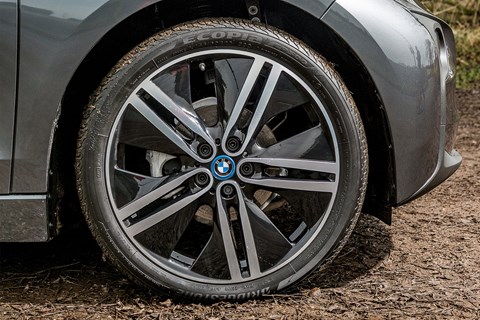
Why the caution? I had a big, unintentional skid on a mucky country lane in a different i3 last year. Nothing untoward has happened in this i3, thankfully…
By Tim Pollard
More BMW reviews by CAR magazine
Logbook: BMW i3 Range-Extender
- Engine 125kW electric motor (equivalent to 168bhp, 184lb ft), with 647cc 2cyl petrol to top up battery
- Gearbox Single-speed automatic, rear-wheel drive
- Stats 8.1sec 0-62mph, 93mph, 13g/km CO2
- Price £31,560
- As tested £37,009 (prices quoted after government Plug-in Grant)
- Miles this month 540
- Total 2953
- Our mpg Haven’t refuelled yet!
- Official mpg 471mpg
- Fuel this month £0
- Extra costs £0
Diary update: learning to live the BMW i life
Time to talk through the nitty-gritty of living with BMW’s pioneering plug-in hybrid. We chose the REX version of the i3 because CAR is based in Peterborough and I live in the wilds of the Midlands countryside. Wouldn’t a pure EV be riskier in rural driving?
That was the thinking, and BMW reports that most i3 buyers agree. In the UK, 70% of sales are of the Range Extender version, countering the earlier launch trend for the battery-only BEV car.
It’s easy to see why. I’m enjoying the reassurance the tiny petrol engine provides. In the past month, I’ve driven our BMW i3 190 miles to Heathrow and back for my flight to the Geneva airport, Ben Miller took it to Thruxton for some racing tuition and Parkers editor Keith Adams and I resisted the urge to go ICE by going EV when we visited Ferrari and Fiat in Slough.
That speaks volumes about our faith in the i3’s real-world range. On longer trips, the tiny 647cc twin-cylinder engine starts up when the range drops to single digits, quietly buzzing in the background as it recharges the battery. At anything other than creeping urban speeds, it’s imperceptibly quiet – though you’ll occasionally notice a clattery start-up when stationary (the twin engine is pretty thrashy compared with a three- or four-cylinder motor).
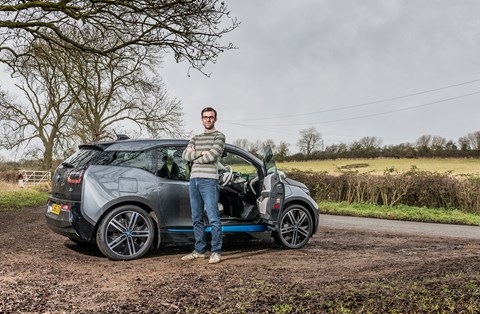
When fully charged on CAR’s workplace Podpoint, the i3 typically manages 110 miles before the range drops to REX mode. That is disappointingly lower than the 195 miles claimed by BMW, but we accept that we do a lot of motorway miles (our offices are just off the A1) and we have been warming the cabin and seats over the chilly winter months.
We expect better range in the summer. Stay tuned for more updates as we continue to adapt to life on the electric superhighway.
By Tim Pollard
Month 1 running a BMW i3: the introduction
Has the electric car come of age? You’ll surely have noticed range creep, as the claimed journey distances achievable on a single charge become ever longer. Renault’s Zoe and the pioneering Nissan Leaf have both been given substantial battery boosts in recent months – and now it’s the turn of the trendsetting BMW i3 supermini.
Which is why we’re running the new i3 94Ah model in 2017, to see if the plug-in car has suddenly become a whole lot more viable. We’ve a sneaking suspicion that it has, as battery technology improves, charging networks expand and range anxiety dwindles. That’s the theory, at least…
To be on the safe side, we’ve plumped for the i3 Range Extender – the one with a tiny 647cc two-cylinder petrol engine snuck under the boot floor to act as a mobile generator and keep you going if you can’t hook up to the mains. Isn’t that the best of both worlds? The ability to drive a pure EV day-to-day, but keep the safety net of extra range just when you need it? Living in the rural Midlands as I do, I find BMW’s quoted 276-mile range tremendously reassuring, giving an extra 90 miles over earlier i3s.
We have electric points at the work CAR park, but I don’t (yet) have a plug in the driveway at home. I’ll investigate residential charging in the coming weeks. This degree of logistical fine-tuning reflects the ground-up rethink that driving an electric car requires from all of us.
It’s clear the old order is being disrupted from all sides. You only have to look at the i3 to realise this is a radically modern car. Its short, squat dimensions and tallboy silhouette still look like a futuristic transport pod, despite being a four-year-old design – it’s quite unlike any other small car. Ours wears the £1080 optional, super-skinny 20-inch alloys (below), lending it a cool, desirable chic, even though I do wish we had chosen a brighter paint colour than the optional gunmetal Mineral Grey (another optional extra at £530).
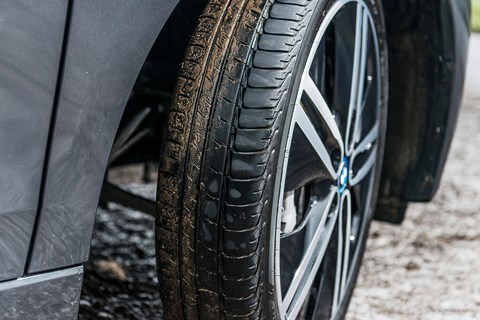
The interior is equally progressive. Ours has the £1000 Loft cabin trim applied, bringing Sensatec artificial leather in Carum Grey and metallic-looking dashboard trims. It’s crisp, distinctive and very modern – especially the exaggerated hippy style of the recycled dash-top materials, flecked by chunks of old newspaper and 8-series of yesteryear. Probably.
Despite its compact dimensions (it’s just 3999mm long), the i3 is roomy in the front for two and visibility is excellent all-round, making it easy to thread along tight city streets. We’ve yet to swing open the suicide rear doors and test the back seats, but it’s useful to know we can transport a family of four without needing a big diesel X5 in convoy to carry the kids.
Will anyone actually use an i3 for family duties? Or will it remain consigned as a city hopabout for well-heeled urbanites? Be sure to drop us a line if you’re running an electric BMW, as we’d love to hear how you’re getting along.
If you own an i3, tweet me here
Chances are, owners will be early adopters unafraid of splashing some cash on a premium product. For the i3 is not cheap. Prices today start at £32,380 after the £4500 government subsidy, which is a heck of a lot for a small car, if not too shocking for a carbonfibre-based electric shock-and-awe machine from BMW.
Of course, many customers will in fact lease their i3, and a main dealer should be able to get you in to a £37k Range Extender like ours for around £306 a month on a Select PCP. This requires a £3999 deposit and a two-year term, with interest charged at 2.9% APR. Suddenly, that nearly £40k list price looks a whole lot more tempting.
Whether you should be tempted or not remains to be seen. I can’t wait to find out if the range is as good as it’s claimed to be. If the ChargeNow network is as readily available and operational when we need to plug in. If the carry-along, range-extending engine can keep us going when we can’t. And how running costs compare with the BMW i8 sports car we’re testing in parallel.
Stay tuned for our regular updates as we find out if the road to iSalvation is a saintly stroll with lashings of feelgood factor or an uphill slog fraught with range anxiety. Let’s hope Electric Avenue’s not a dead end…
Logbook: BMW i3 Range-Extender
- Engine 125kW electric motor (equivalent to 168bhp, 184lb ft), with 647cc 2cyl petrol range-extender to top up battery
- Gearbox Single-speed automatic, rear-wheel drive
- Stats 8.1sec 0-62mph, 93mph, 12g/km CO2
- Price £31,560
- As tested £37,009 (prices quoted after Government Plug-in Car Grant)
- Miles this month 31
- Total 2413
- Our MPG TBC
- Official MPG 471
- Fuel this month £0
- Extra costs £0
View BMW i3 lease deals
Click here for more BMW reviews by CAR magazine
